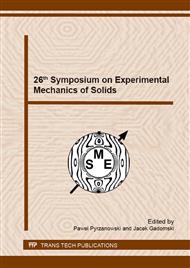p.108
p.114
p.122
p.128
p.137
p.143
p.149
p.155
p.161
Possibility of Usage of Aluminium Rivet Nuts Connections in Composite Materials
Abstract:
Development and application of composite materials in modern industry are very dynamic. Composite materials seem to be replacing steel and aluminium ones. Composites are a cheaper solution, with similar mechanical strengths. Generally, there are two types of joints in composite structures: mechanical and adhesively bonded ones. The aim of the study was to determine the feasibility of riveted joints in composites materials. Static tensile test method was used. In the test there was used one type of glass fabric (Interglas 92140) from which two types of composite samples were prepared. In each sample there was used the same type of fiber with the same fiber orientation – 3 layers. Samples had dimensions of 220x100 mm and thickness of approximately 1.5 mm. They were connected to each other with aluminium rivet nuts (from 1 to 3) and placed in a metal frame with a screw connection which was made of screws with nominal thread pitch M5. Screws were tightened with constant torque. It was to provide an axial force to the sample during the tensile test. The frame was placed between cross-bars of tensile machine INSTRON 8516. The samples were stretched at a speed of 0.05 mm/s at a distance up to 20 mm. During the tensile test displacement of the samples and pull force were registered. Depending on the fiber orientations and number of rivet nuts composite damage models were described. On the basis of the results the possibility of usage of aluminium rivet nuts connections in composite materials was determined.
Info:
Periodical:
Pages:
137-142
Citation:
Online since:
August 2015
Keywords:
Price:
Сopyright:
© 2016 Trans Tech Publications Ltd. All Rights Reserved
Share:
Citation:


